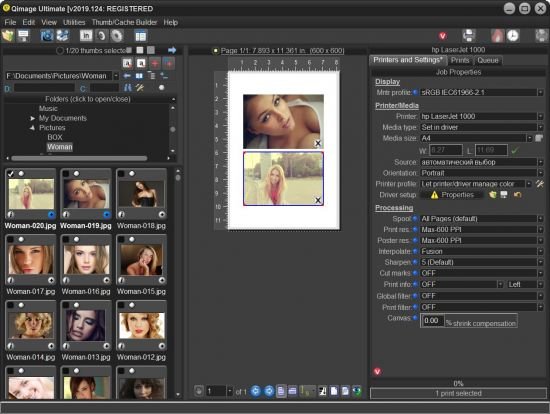

This will allow Qimage One to initialize and copy the plugins for Adobe Photoshop and Lightroom. Once the installation is complete, you should run Qimage One for the first time.
#Qimage ultimate resize install#
When you have downloaded the Qimage One installation package, you should run the package, which will install Qimage One in the Applications folder. A complete help reference for Qimage One will be available soon. For videos of the process, click here.Īnd, for more videos about printing, coating and stretching canvas, click here.This guide will help you get started using Qimage One on the macOS operating system.

While overall material costs are a little more than if you made the frames by hand, each canvas wrap will be faster than doing it by hand, but will obviously take longer than using a machine. Tara Materials also offers easy-to-assemble tongue-and-groove stretcher bars so you don’t have to buy the raw materials and cut them down to size.

This is a happy medium between stretching by hand and automating the process. The third option is the use of a pre-made DIY stretcher bar kit, which include kits by Hahnemuhle and LexJet Sunset. To find out more about the setup and operation of the Studio Canvas Master and the Canvas Stretch Master, click to the videos below:Ĭorner Fold Options DIY stretcher kits like Sunset Stretcher Bars are a quick and simple solution for canvas finishing. However, it also produces about twice as many canvas wraps per hour than the Tensador II and the Canvas Studio Master, about 60 per hour on the high side, with less labor. The Canvas Stretch Master is more automated, thus it’s more expensive.
#Qimage ultimate resize how to#
Garcia adds that it usually takes one of their operators about a day and half to learn how to use the machine to its full potential and cuts the time needed to do a canvas wrap by anywhere from 30-50 percent. I can’t think of a situation where we wouldn’t use the machine, unless it was an original canvas.” The Canvas Stretch Master from LexJet automates and speeds up the canvas wrap process for production printing and finishing. When you compare it to doing it by hand, the machine always wins out. If your volume supports the equipment purchase, definitely investigate these machines.Īrmando Garcia, director of operations for Soicher Marin, a high-volume fine art reproduction company is Sarasota, Fla., says, “We use the Tensador for just about everything up to 60 inches. While much more efficient for production, acquiring equipment like the Tensador II or the Canvas Master requires an initial investment ranging from about $3,000 to $11,000. For detailed step-by-step instructions by master printer, photographer and craftsman Ralph Cooksey-Talbot on creating your own stretcher bars and canvas frames, including the tools and materials necessary, click here. Stretching canvas by hand can be very involved and time-consuming, but the raw materials needed are less expensive. Typically, there are three ways a canvas print can be stretched: by hand, with stretcher bars and strainers using canvas stretching machines that provide a range of automation, like the Tensador II and the more automated Canvas Master machines by GAPP Engineering or using a do-it-yourself stretcher bar system.
#Qimage ultimate resize skin#
Click here to see how it’s done.Īlien Skin Software: Alien Skin’s Blow Up software comes with a free Photoshop Gallery Wrap Panel to make a solid border, reflected edges or reflected edges with a fade. Qimage Ultimate: This imaging software tool offers a number of ways to work with print borders. OnOne Software, Perfect Resize 8: Formerly known as Genuine Fractals, with Perfect Resize you can create selective, mirror, museum-wrap and other types of wrap borders. You can do this manually in Photoshop and then record your actions.Ĭanon Layout Plug-In: If you have a Canon iPF inkjet printer, the Layout Plug-in software features a tool that automates the process. Photoshop actions: Typically, the Clone tool is the primary tool used to create a mirrored border. Fortunately, there are quite a few options… The trick is getting this right before you print. A museum wrap substitutes a solid border along the edges. A gallery wrap, by the way, is where the image continues to bleed onto and over the edges. Before we get into the physical stretching and wrapping of canvas, this seems a good spot to discuss ways in which you can prepare the file before printing so that it’s ready to be rendered as a gallery or museum wrap.


 0 kommentar(er)
0 kommentar(er)
